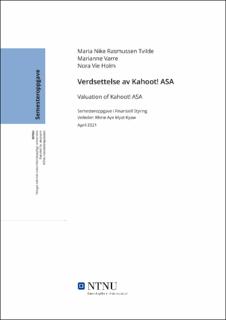| dc.contributor.advisor | Kyaw, Khine Aye Myat | |
| dc.contributor.author | Tvilde, Maria Nike Rasmussen | |
| dc.contributor.author | Varre, Marianne | |
| dc.contributor.author | Holm, Nora Vie | |
| dc.date.accessioned | 2022-02-01T18:30:55Z | |
| dc.date.available | 2022-02-01T18:30:55Z | |
| dc.date.issued | 2021 | |
| dc.identifier | no.ntnu:inspera:80215350:80496672 | |
| dc.identifier.uri | https://hdl.handle.net/11250/2976517 | |
| dc.description.abstract | Vi har valgt følgende problemstilling: Hva er Kahoot! ASA verdt per 31.12.2020? I vår fundamentale verdsettelse av selskapet tar vi utgangspunkt i regnskapstall fra 2015-2020 og annen sekundærdata.
Den strategiske analysen består av strategimodellene PESTEL, Porters bransjeanalyse og SVIMA, før vi oppsummerer alt i en SWOT-analyse. Dette for å belyse både interne og eksterne faktorer, samt kartlegge hvilke styrker, svakheter, muligheter og trusler Kahoot! har og må forholde seg til.
Regnskapsanalysen viser at Kahoot! har hatt svært dårlig lønnsomhet hele perioden. Vi ser riktignok en positiv trend, spesielt i 2019 og 2020 har tallene bedret seg. Videre viser analysen at Kahoot! har god finansiering, soliditet og likviditet sammenlignet med generelle normer og krav. De fleste nøkkeltallene har vært spesielt tilfredsstillende de to siste årene.
I den finansielle analysen har vi brukt CAPM for å beregne avkastningskravet på egenkapitalen, og WACC for å beregne avkastningskravet på totalkapitalen. Videre har vi prognostisert fremtidige kontantstrømmer for de neste fire årene. Til slutt har vi verdsatt Kahoot! ved hjelp av DCF-metoden og ved hjelp av en multippel analyse. Etter DCF-metoden kommer vi frem til en netto nåverdi på NOK 38 211 158 715, eller en aksjeverdi på NOK 85,66. Sammenlignet med markedsverdien per 31.12.2020 som var på NOK 95,20 ser vi at aksjen var overpriset. | |
| dc.description.abstract | We have chosen the following issue: What is Kahoot! ASA worth as of 31.12.2020? In our fundamental valuation of the company, we use accounting figures from 2015-2020 and other secondary data.
The strategic analysis consists of the strategy models PESTEL, Porter’s five forces and SVIMA, before we summarize everything in a SWOT analysis. This is to shed light on both internal and external factors, as well as identify the strengths, weaknesses, opportunities and threats that Kahoot! has and must deal with.
The accounting analysis shows that Kahoot! has had very poor profitability throughout the period. We do see a positive trend, especially in 2019 and 2020 the numbers have improved. Furthermore, the analysis shows that Kahoot! has good financing, solvency and liquidity compared to general norms and requirements. Most key figures have been particularly satisfactory in the last two years.
In the financial analysis, we have used CAPM to calculate the required return on equity, and WACC to calculate the required return on the total capital. Furthermore, we have forecasted future cash flows for the next four years. Finally, we valued Kahoot! using the DCF method and using a multiple analysis. According to the DCF method, we conclude with a net present value of NOK 38,211,158,715, or a share value of NOK 85.66. Compared with the market value as of 31.12.2020 which was NOK 95.20, we see that the share was overpriced. | |
| dc.language | nob | |
| dc.publisher | NTNU | |
| dc.title | Verdsettelse av Kahoot! ASA | |
| dc.type | Bachelor thesis | |
